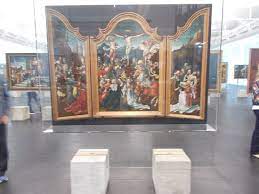Museum Wiesbaden
Museum Wiesbaden
The Museum Wiesbaden is a two-branched museum of art and natural history in Wiesbaden, Germany. Along with the museums in Kassel and Darmstadt, it is one of three Hessian State museums.
History
The origins of the original three museums can be traced back to the citizens of Wiesbaden and Johann Wolfgang von Goethe, who stayed in Wiesbaden for a rehabilitation measure in 1814/1815 and worked hard to establish such a cultural institution. In 1825, he persuaded Frankfurter private collector Johann Isaac Freiherr von Gerning to donate his extensive collections of works of art, antiquities, and in kind to the Duchy of Nassau in exchange for a life annuity. Citizens of Wiesbaden and the surrounding region were able to rapidly expand these collections under the supervision of newly formed associations but under the control of the ducal government. In collaboration with the Verein für Nassauische Altertumskunde und Geschichtsforschung ("Association for Nassauian Antiquity and Historical Research") founded in 1812, three initially independent museums emerged. In addition to the Verein für Nassauische Altertumskunde und Geschichtsforschung, the Nassauischer Verein für Naturkunde ("Nassau Society of Natural Science)" and the Nassauischer Kunstverein ("Nassau Kunstverein") (art society) were in charge of these museums.
Collection of artworks
The museum's art collection dates back to Johann Isaak von Gerning's former collection in Frankfurt. The art collection has grown to be one of the most important in Germany, particularly in the 19th and 20th centuries, thanks to purchases, donations, and loans. The Museum Wiesbaden makes every effort to identify Nazi loot in its own collection and, if necessary, return it to the rightful owners. As a result, in October 2014, the museum launched a spectacular campaign titled Wiesbaden schafft die Wende! ("Wiesbaden is rounding the corner!") The museum acquired Hans von Marées' painting Die Labung, which was stolen by the Nazi regime in 1935, in 1980. In the context of this action, it was still shown, But only the opposite side of the painting. The painting could not be returned until the beginning of November, by which time donations had raised enough money for the now-legitimate purchase.
Sculptures
Sculptures play no significant role in the Museum Wiesbaden's art collection. However, there are some interesting works on display. Aristide Maillol's Badende is one of the main representatives of French sculpture from the late nineteenth and early twentieth centuries. Max Klinger (portrait bust of Friedrich Nietzsche, ca. 1910), Franz von Stuck, Georg Kolbe, Wilhelm Lehmbruck, Gerhard Marcks, Emy Roeder, and Ernst Barlach are among the German sculptors of the first half of the twentieth century (Der Tod, 1925).
Graphic design
The graphic art collection is less important than the painting collection. Work from before 1800 is hard to come by. In the nineteenth century, however, there are works by Ludwig Knaus, Arnold Böcklin, Hans von Marées, and Max Slevogt, among others. The expressionists, particularly Alexej von Jawlensky, stand out in the first half of the twentieth century (see Alexej von Jawlensky-Collection, excellently represented with drawings, woodcuts and Lithographs). Works by Die Brücke artists such as Ernst Ludwig Kirchner, Erich Heckel, and Karl Schmidt-Rottluff, as well as artists from the Blaue Reiter-Editorial Association, are included. The collection includes works by Franz Marc, August Macke, and, most notably, Wassily Kandinsky's watercolour Allerheiligen ("All Saints," 1910).
Geological timeline
In the immediate vicinity of Wiesbaden, three geological eras are particularly well represented. There are approximately 50,000 documented fossils. There are Pleistocene testimonies from the recent history of the earth, particularly from the Mosbacher Sande . The Rhine and Main had regularly dammed up in front of the Middle Rhine Valley, and bones carried along had become embedded in the sediment. Numerous fossils have been preserved, particularly from warm periods. The find area at the Caves of Steeden, where the oldest artefacts of Hesse were discovered, is a second focal point. One of the most important collections is related to the two earth ages listed below. It is the most significant part of the Sandberger brothers' legacy.






Comments
Post a Comment